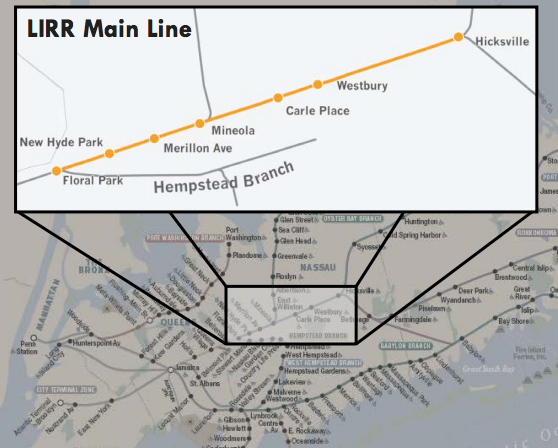This morning, Governor Cuomo announced plans to move forward with the Long Island Railroad’s project for a third track on the main line between Floral Park and Hicksville in Nassau County. At the same time, Cuomo wants to study a car tunnel linking Long Island to either the Bronx, Westchester, or Connecticut.

The LIRR project will lay 9.8 miles of track, primarily in the existing right of way, increasing capacity and hopefully spurring walkable development along one of the railroad’s busiest corridors. Expanding the main line will help existing commuters and wring more value out of the region's most expensive mega-project, the East Side Access tunnel connecting LIRR to Grand Central.
Currently, nearly two-fifths of LIRR riders use the main line's two tracks. With the Ronkonkoma, Port Jefferson, Montauk, and Oyster Bay branches all converging on the main line, service in the peak direction runs on both tracks during rush hours, severely constraining travel in the other direction. Small hiccups in operations often lead to major delays. With the additional track, ridership is expected to increase 40 percent, Cuomo said.
Regional transportation advocates have been calling for a third track for years. A 2014 study by the Long Island Index estimated that, in the 10 years following its completion, the project will bring 14,000 jobs, 35,000 residents, and $103 million in annual property tax revenue to the region.
“This is a project that is critical for Long Island,” said Tri-State Transportation Campaign Executive Director Veronica Vanterpool. “It’s critical if Long Island wants to address their congestion issues. It’s critical if Long Island wants to be a community that sheds its bedroom community status.”
Speaking to the Long Island Association, a local business group, Cuomo said his proposal would avoid the pitfalls that previous third track plans have encountered. Cobbling together right-of-way for the new proposal will only affect 30 commercial properties and 20 residences, compared to about 200 businesses and residences combined for the previous iteration. The average residential acquisition will be just five square feet. It's not yet clear how these changes will affect the project cost, which was last estimated at $1.5 billion.
Vanterpool lauded the governor’s proposal. “It’s a project that has to happen," she said. "The infrastructure in that area has not been updated since 1844, when there were only 50,000 people on Long Island.” Today, nearly 2.7 million people live in Nassau and Suffolk counties combined.
Vanterpool said the new proposal looks like an attempt to address the not-in-my-backyard opposition that led to the removal of the project from the MTA’s capital plan in 2008. That proposal was defeated by a small but vocal group of people who own property by the right of way.
The region is more open to transit-oriented growth than it was the last time around, said Eric Alexander of Vision Long Island. In Nassau and Suffolk over the last nine years, 11,000 units of housing have been approved near transit and another 20,000 are moving forward, according to Alexander. Still, he said, "It can’t just be a group of people from outside the community saying, ‘Trust me it’s good for you.' I think that’s where past proposals have failed.”
Also at this morning’s event, Cuomo announced a $5 million study exploring the possibility of a new tunnel connecting the region with Westchester, Connecticut, or the Bronx, as well as $50 million for parking near the Ronkonkoma LIRR station.
Vanterpool said she did not see a need for the tunnel study. "I don’t think we need another study right now. Put that money towards projects that need the money right now," she told Streetsblog. "We have so many existing shovel-in-the-ground projects that don’t have money where $5 million would go a long way."
The Long Island proposals are a prelude to what Cuomo is calling "the most ambitious transportation development plan in modern history," reports Politico. Presumably, the governor was referring to the release of more details about how he plans to fund both the MTA capital program and upstate road spending. So far, the governor's approach to these issues has been anything but ambitious.





